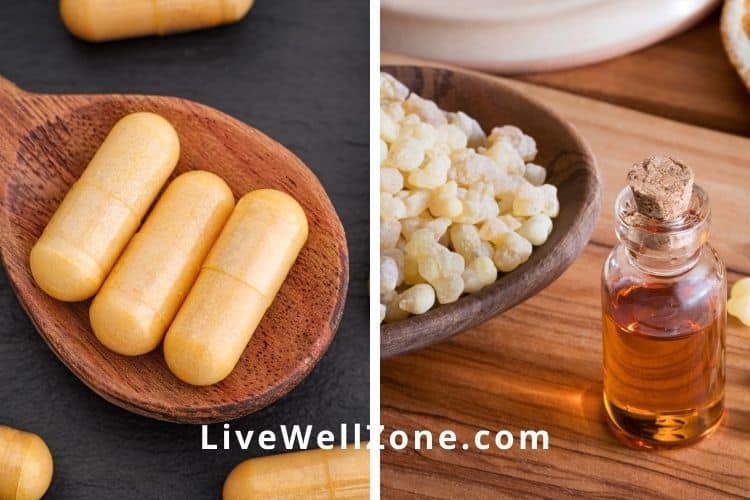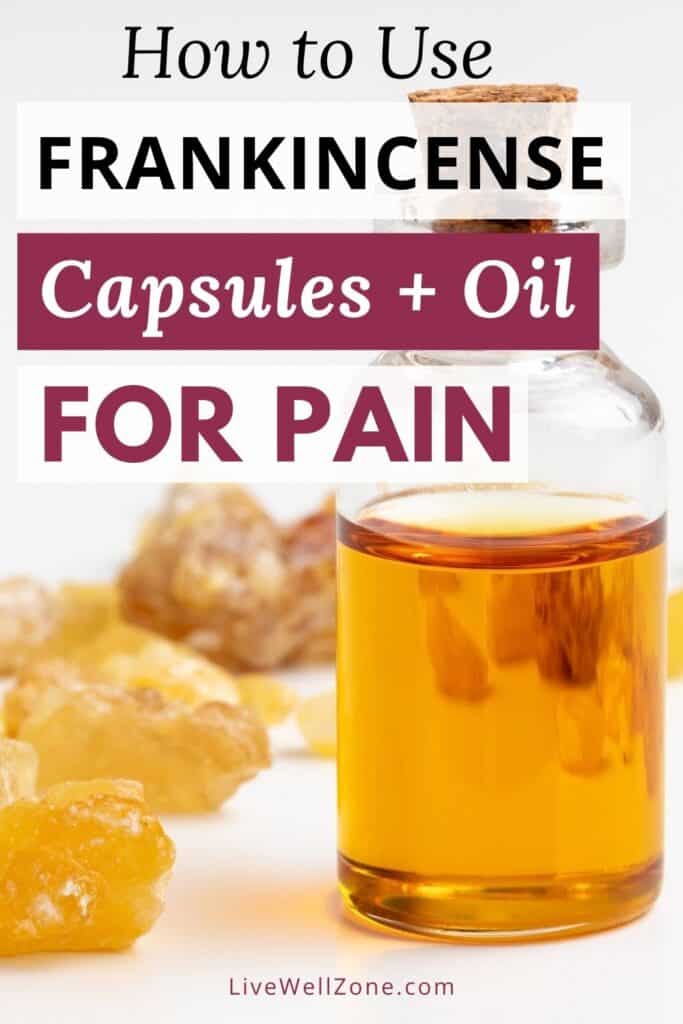
With several varieties of frankincense (aka boswellia) available to us these days, it can be a little tricky to know which one is best for pain and inflammation.
In general, frankincense serrata is the best choice for general inflammation, including the pain associated with arthritis, menstrual cramps and ulcerative colitis. In order to get the best results from frankincense it is important to know what concentration, extraction method and supporting ingredients to look for.
Please note even though there are seven types of frankincense varieties, they all have some degree of anti-inflammatory activity. Throughout this article we will be looking at how frankincense relieves pain and where relevant, I will be highlighting benefits that are unique to a specific type.
Below is a brief overview of the four most common types of frankincense and their general benefits (source).
| Frankincense serrata | Well studied and considered most anti-inflammatory. |
| Frankincense carterri | Anti-inflammatory (suitable for bruises or scratches). |
| Frankincense frereana | Anti-inflammatory (particularly beneficial for skincare). |
| Frankincense sacra | Anti-inflammatory. Stands out for its stronger aroma compared to other types. |
Note: this post contains affiliate links and I earn a commission (at no additional cost to you) if you use them to make a purchase.
FRANKINCENSE BENEFITS FOR JOINT OR MUSCLE PAIN: HOW IT WORKS
According to the Arthritis Foundation, frankincense contains various boswellic acids that block the enzyme 5-LOX (5-lipoxygenase). 5-LOX is involved in the synthesis of leukotrines, which are molecules that can attack joints and tissues, resulting in pain and inflammation. By blocking this cascade of events, frankincense is able to provide relief from various types of pain, including joint pain (source).
In addition, research suggests that frankincense might be able to reduce cartilage damage in people with arthritis, a benefit that would help to ease pain.
Aside from its boswellic acid content, frankincense contains compounds known as terpenes, many of which may have analgesic (pain-blocking) and anti-inflammatory properties (1, 2, 3). Some of these include:
- Alpha-pinene (highest in sacra type).
- Alpha-thujene (highest in frereana type).
- Linalool.
HOW TO USE FRANKINCENSE EXTRACT AND OIL FOR INFLAMMATION
The Arthritis Foundation recommends the following dosages of frankincense extract for pain relief (source):
- 100mg for osteoarthritis.
- 1200 – 3600 mg for rheumatoid arthritis.
Aside from the extract, you can also use frankincense essential oil topically for pain relief. In this case, experts like the Tisserand Institute suggest a 5 – 20% dilution (source).
Yes, that’s a very wide range! It would be nice to have a more precise number but pain varies tremendously from one person to another.
So, if you do want to try topical use of frankincense oil for pain, start with a 5% dilution and if necessary, work your way up.
To make a 5% dilution use a light carrier oil such as grapeseed, almond or fractionated coconut oil. Here’s a chart that explains how to dilute frankincense oil for pain:
| 10ml (1/3 oz) | 15ml (1/2 oz) | 30ml (1 oz) | |
| 5% | 15 drops | 22 drops | 45 drops |
| 6% | 18 drops | 27 drops | 54 drops |
| 7% | 21 drops | 31 drops | 63 drops |
| 8% | 24 drops | 36 drops | 72 drops |
| 9% | 27 drops | 40 drops | 81 drops |
| 10% | 30 drops | 44 drops | 90 drops |
Lastly, if you’re curious about using frankincense specifically for menstrual pain, check out this article for tips and recipes.
CHOOSING THE BEST FRANKINCENSE FOR PAIN RELIEF
Of the different types of boswellic acids that are in frankincense, AKBA (Acetyl-11-keto-beta-boswellic acid), seems to have the most anti-inflammatory and analgesic (pain-blocking) abilities.
1. How to choose a frankincense supplement (extract) for pain
Check the ingredients list for:
- AKBA: standardized to 30% (source).
- Supporting ingredients: some brands include black pepper (often listed as piperine, black pepper extract or the trademarked name, BioPerine) or lecithin (usually from sunflower) in their formulas as they may help with the absorption of frankincense.
Based on the above, here are 2 frankincense supplements that you can look into:
Thorne Boswellia Phytosome (available here on Amazon):

- Contains 350mg of frankincense extract with sunflower (aids with absorption as mentioned earlier).
Tribe Boswellia Complex (available here on Amazon):

- Contains the equivalent of 562 mg of frankincense extract, as well as ginger (also a powerful anti-inflammatory herb) and black pepper extract.
2. How to choose a frankincense essential oil to alleviate inflammation
The very best frankincense oil that you can buy is a CO2-extracted oil. This simply means that carbon dioxide was used for the extraction process.
CO2-extraction produces the finest quality essential oils. In fact, CO2 extracted oils have some components that are simply not found in oils that are distilled via steam distillation.
But here’s the thing: CO2-extracted essential oils are not the norm. In fact, after doing quite a bit of digging among some of my favorite brands, I noticed that they all offer only CO2 extracted carterri. So, all the links that I share below are for steam distilled serrata (since that type is prioritized for pain relief). But if you do come across a CO2 serrata, I suggest giving it a try as well.
Here’s a frankincense serrata essential oil you can use from one of my favorite brands. This isn’t pre-diluted and should not be applied to the skin as is. Instead, use the dilution chart above to make your own blend.

For a hybrid experience, this frankincense blend contains all seven varieties. This isn’t pre-diluted and should not be applied to the skin as is. Instead, use the dilution chart above to make your own blend.

FAQs ABOUT THE BENEFITS OF FRANKINCENSE FOR INFLAMMATION
Is frankincense and myrrh good for arthritis?
According to a 2015 study, oral administration of frankincense (boswellia carterri) and myrrh suppresses the progression of arthritis in rats. The combination of these two ingredients seems to regulate the MAPK (mitogen-activated protein kinase) pathway which is involved in our stress and inflammatory response (source).
CONCLUSION
Whether taken orally or applied topically, frankincense has a significant amount of anecdotal and scientific evidence to support its use as an anti-inflammatory agent.
Do keep in mind that frankincense can interact with other medications including ibuprofen, antidepressants and more. In addition, it may stimulate the immune response, which could be an issue if you have an auto-immune condition.
So, it’s best to always check with your doctor before using frankincense as a pain or inflammation remedy.

Related Articles:

